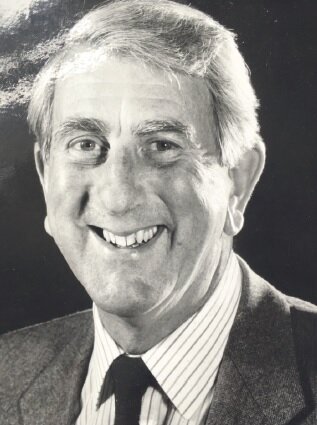1924 - 2020
By Christopher Maidment (with contributions from George Hill and Ian’s own memoirs)
Ian was born on 10th October 1924. His parents, Jimmy Nelson and Betty Thorne, had met towards the end of the First World War at a mobile YMCA canteen at Euston Station.
Ian was nearly 15 when the Second World War broke out. He lived with his parents and sister close to Croydon Airfield, or ‘bomb alley’ as he referred to it. One of Ian’s first memories of wartime activity was admiring a squadron of planes flying northwest in the late afternoon sunshine sometime in 1940, only then to see tiny black objects falling from them. The target was Croydon Airfield, but the major damage was caused to the ‘Evening in Paris’ perfume factory nearby – the resultant ‘pong’ lasted for days.
An early childhood accident when charging around the Christmas tree in the middle of the room and falling into the fireplace severely burning both hands did not prevent him following his father into dentistry. His further education was at Guy’s Hospital School of Dentistry, which set him on his future career. Being of service age he was posted as a dentist into the RAF and had several amusing stories of dealing with ‘top brass’ toothache!
After National Service - between 1951 and 1980 - he divided his time between his Practice in Brighton, where he lived with his wife Jean, and lecturing at Guy’s Dental School, eventually selling his practice in 1981 but continuing at Guy’s as a lecturing professor until 1990. Subsequently they moved to Hassocks and then to Hurst in 1984. Here they found satisfaction and stayed, initially with their five children, until the end of his life, having had 72 years of marriage.
Ian had completed an OU (Open University) degree before he left Guy’s in 1990, providing him with a new and totally different interest for retirement. His interest in history had been with him since schooldays. The last degree module dealt with local history. His tutor suggested that it should be published, but as this meant rewriting it for Local Population Studies, a periodical with a totally different readership, he resisted doing this for some weeks. Eventually he gave in and, much to his surprise, it was accepted. This led Ian to a day course at the University of Sussex and evolved into a D.Phil. thesis on the Poor Law activities across 28 parishes, which led to collaboration with Sussex Record Society.
At Hurst, Ian entered fully into the spirit of the village, which he learned to love. He set about learning the history of the place and its former inhabitants, spending countless hours at the records office in Chichester. He joined a group which led to the formation of the Hurst History Study Group and the publication of ‘HURSTPIERPOINT – kind and charitable’ under his editorship.
Ian was involved in the research, writing or publication of ten books. The last was ‘Who’s been living in my house?’, recording the occupants of the individual properties in the High Street during the reign of Queen Victoria. He was honoured to be asked to be President of Hurstpierpoint Historical and Geographical Society after the death of Ray Packham, an honorary post he held until he died. Bill Kent, chairman of the Society, says: “I often received questions about obscure matters of local history. I invariably referred them to Ian who answered them with typical patience and politeness. He was a lovely man who will be greatly missed.”
During the whole of his retirement period, other village activities took up most of his time. At Holy Trinity Church, where he worshipped week by week, he took on the task of opening and closing the building – a far cry from the days of Stewardship Campaign chairman and the two stints as churchwarden in the 1970s and the 1990s. He promised himself not to continue with any one project for more than ten years; so was ten years chairman of the Lifeboat Committee, helping to raise funds for the RNLI; ten years a governor of St Lawrence School and ten years conducting his famous ‘Walks Around Hurst’ taking small parties through the village, thus showing off its highlights and its history. This also raised many hundreds of pounds for charity. He believed that voluntary activities such as these need new ideas from time to time – and in any case, younger people should be persuaded to take over!
Paul Dyer, who recently retired as Headmaster at St Lawrence School reflected that: “Ian was a school governor for whom I had the greatest respect. We worked together for many years when he was chair of the personnel committee, and he and June Wilmore joined me in making some very important appointments. He was the epitome of a school governor. Ian always seemed indestructible; a great man.”
Perhaps the most significant thing was the result of a casual conversation with Harry Brown (of Brown Twins notoriety), who had been the driving force behind the local Scout Group’s fundraising for their new headquarters, raising the £150,000. Once the target had been reached, Harry was planning to cease the operation, but Ian thought the idea could be expanded for the benefit of the whole community. So the Hurst Community Charity Shop was started. After two years carrying on as the Scouts had done in empty shops at no rent, the old Scout HQ was leased from the Parish Council in 1998. Ian was among the founder trustees, but again only for ten years, raising over £500,000, shared between church redevelopment and projects in the parish as a whole. Ian was given a Golden Jubilee medal by Mid Sussex District Council in 2002, and a Community Service Award …ten years later.
In 1996 he was diagnosed with a prostate tumour. This was treated initially by surgery and radiotherapy. Difficult to believe, but Ian was sent to consultant Tim Larner, the son of one of his early students at Guy’s, who was having a high degree of success with a relatively new procedure. In spite of his age, Ian was considered a suitable case for treatment, and so in November 2010 this was done and with total success.
The ‘Mafia’, a cohort of Hurst friends, had several trips and holidays on the river Avon. Going downstream the second year, the river was in spate and they were unable to go under the bridge at Luddington Lock, and were marooned for three days; ample time for George Hill to compose ‘The Ode of Luddington Lock’ in memory of the occasion.
Another trip to Ypres on Armistice Day, visiting the Menin Gate and the huge military graveyard at Tyne Cot, where Ian discovered ‘on the wall memorial to those whose bodies were never found, the name of the Somerset Light Infantry officer who had recommended Father for a commission, thus sending him out of the front line just when his regiment suffered so many casualties – if it hadn’t been for Captain Mason, I might not have been here’.
A classic story of Ian’s came about when asked: ‘Why does Pitt Lane have two ‘t’s?’ He recited the tale that one day he was walking in the lane with the late John Worsley of West Furlong House. They came across a young man who looked lost. The man introduced himself as being from Ordnance Survey and inquired to the name of the track. “Pit Lane”, retorted John, but before Ian could inform the mapping professional that the lane led to a former sand and gravel pit at the bottom of the hill, the rather mischievous Mr Worsley exclaimed: “That’s with two ‘t’s, named after Pitt The Younger, our country’s youngest ever Prime Minister!“ - which of course was nonsense - but ‘Pitt Lane’ it is!
While this in itself should become a part of village folklore, Ian will never be forgotten here, not only with a bench on the village green facing the church and Compton House beyond it but, also planned, the twitten between the High Street and Trinity Road will be named IAN NELSON WALK.
He was a man of many parts – walking his dog for miles and playing tennis into his 90s. His general knowledge was formidable; he was definitely the man to have in your quiz team! Hurst has lost a fine man who loved and served this village.
First published in the August 2020 issue of Hurst Life Magazine.

